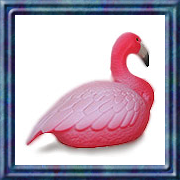|

Classic Pink
Flamingo Rubber Ducks
Flamingos filter-feed on brine shrimp. Their
oddly-shaped beaks are specially adapted to separate mud and silt
from the food they consume, and are uniquely used upside-down. The
filtering of food items is assisted by hairy structures called
lamellae which line the mandibles, and the large rough-surfaced
tongue. The flamingo's characteristic pink colouring is caused by
the
Beta carotene in their diet. The
source of this varies by species, but shrimp and blue-green algae
are common sources; zoo-fed flamingoes may be given food with the
additive
canthaxanthin, which is often also
given to farmed
salmon
Flamingos frequently stand on one leg. The reason
for this behavior is not fully known. One common theory is that
tucking one leg beneath the body may conserve body heat, but this
has not been proven. It is often suggested that this is done in part
to keep the legs from getting wet, and in addition to conserving
energy. In addition to standing in the water, flamingos may stamp
their webbed feet in the mud to stir up food from the bottom.
In
Ancient Rome, flamingo tongues were
considered a delicacy. Also, Andean miners have killed flamingos for
their fat, believed to be a cure for tuberculosis
The
Moche people of ancient
Peru worshipped nature. They placed
emphasis on animals and often depicted flamingos in their art.

$11.99
Also available
Flamingo in the Wild
 Our First Limited Edition
Only 2100 Produced Young flamingos
hatch with grey plumage, but the feathers of an adult range from
light pink to bright red due to the bacteria in the water they
inhabit and the pigments obtained from their food supply. Notable
exceptions are the flamingos not fed foods containing
sufficient amounts of beta carotene, whose plumage will be a lighter
pink, almost white, color.

$11.99
Not intended as a toy for ages 13 and under. |

